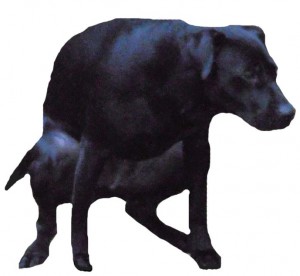Scent with a message
December 16, 2014 – Humans separate smells into good and bad, but for pets they’re all good, they’re all part of the picture and they’re worth more than a thousand words. When our noses get a whiff of the neighbor’s burgers on the barbecue; our dogs are busy sniffing the meat, the condiments, the guests, the cat and, most likely, a Squirrel in the tree; any one of which can peak their interest. Why would smell be so important to animals? Sight can be shielded, sound can be squelched, touch is too tricky, and taste is too tacky. The only sense that can compete with the tactics of evasion is that of smell, and for dogs, their nose is a hundred thousand, maybe a million, times more sensitive than ours, and lasts a lifetime.
I get the part about smelling for food, smelling for a mate, or smelling for shelter, but how can smelling a rear end, a pile of poop or a mark of urine be a good thing? And what’s with the rolling on dead birds? Dogs are disgusting; cats would never do that!
Ever hear the expression, “Monkey see; Monkey do?” Although that accounts for some of their behavior; “Doggie smell; Doggie do,” is more befitting. Dogs mark to be noticed, hence they can’t wait to put their scent over another’s; but cats mark to be left alone, so they’re not going to tread on another’s warning sign. It’s kind of like the two doors, marked “Women” and “Men;” it’s universally understood what’s going on there, and if not; the smell should set you straight. In a world without words, smell marks the spot; and when sniffed by a dog; it’s only reasonable to act accordingly.
Of the urine, poop, oil, sweat and saliva; urine (aka pee mail) is by far the most valued member of the marking media; primarily because of its frequent availability, variable trajectory, distinguishable odor, easy access by followers, and disposable nature. But not to be outdone is the poop chute that comes equipped with two equally impressive aromatic markers; the anal sacs or “scent glands.” Anal sacs are lined with sweat glands that produce a fluid, not unlike perspiration, that rivals the eye watering stench of a day old dead fish. Whether contained in the sacs or spattered on the stool; to a poop sniffing, bottom bumping dog; it’s worth its weight in gold. Skunks have similar sacs that are nothing short of life savers.
What’s more tenacious than a film of gooey, gummy oil? Not much, hence it makes a nearly indelible marker. Problem is… for pets, it’s not very plentiful, it’s difficult to apply, it’s covered by hair and it’s essential for skin. So why use it; because animals work with what they got. Cats use their face, paws and backs to rub it on pant legs, knead it on night shirts and paint it on walls. Dogs use their back and shoulders to rub it on irresistibly attractive objects. Does that answer the age old question: Why do dogs roll on repulsive things? Maybe. Speculation about covering their scent for protection from predators, attracting others with a better scent than their own, wearing a new preferred scent, or showing off a unique smell may be giving too much thought to a simple minded dog whose main goal in life is to mark his territorial treasures. They don’t pee on it, poop on it, or scratch at it; instead they rub against it with the oiliest, and broadest, part of their body; their neck and shoulders. They could scoot on it, but that’s another story.
Bottom line: Dogs utilize the benefits of unusual scents, not for the sake of embarrassing their human companions, but rather as a way to send and receive messages from their friends that are present, recently present, or likely to be present.

